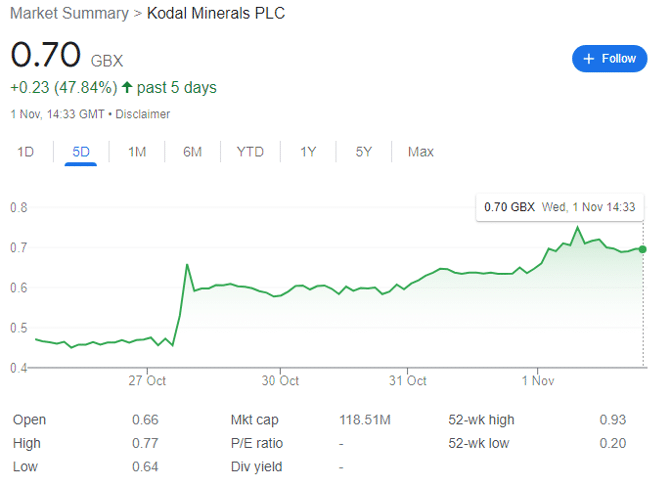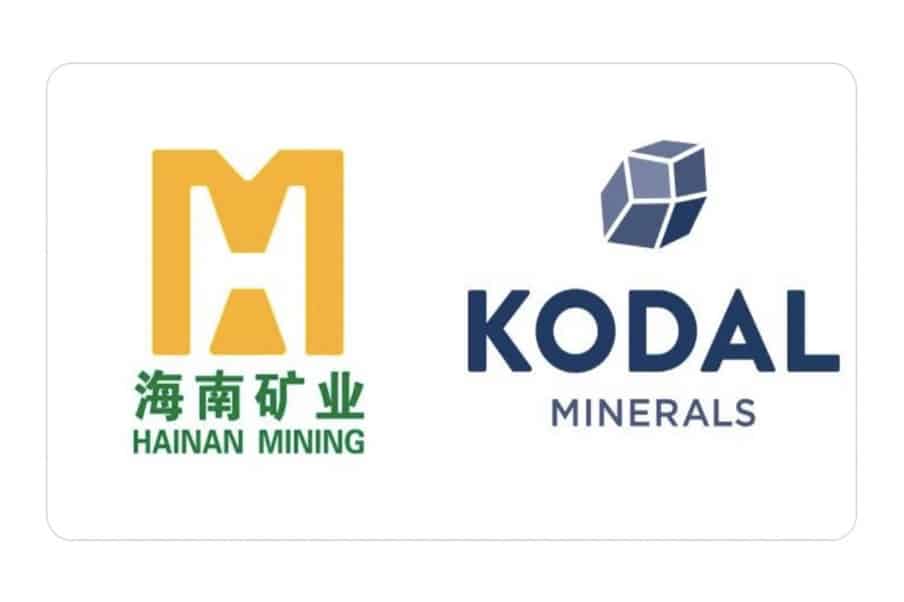The following part of the article was updated March 7, 2024:
Kodal Minerals is rising once again — long term investors will now wait patiently. Here’s why.
In the junior resource sector, there are a handful of simple investing ‘rules’ that are easy to follow. One of these is to buy shares in companies that have a solid investment case but are not currently in the headlines. The reason for this is simple; when a stock is taking up headlines, it’s generally going to soar on the day.
But then traders take profits.
And if there is little news flow for some time, investors sell out.
And the stock gets depressed. Sellers attract sellers and a solid company with an excellent investment case gets pummelled. And this described Kodal Minerals fairly well pretty recently.

Okay, 158% in five years is not exactly poor performance, but the slide from 0.88p almost a year ago (and 0.68p in November) to 0.44p today means plenty of investors are left waiting for Godot. With SC6 pricing hopefully now bottoming (though those pesky analysts at Goldman Sachs continue to be a fly in the ointment), one would hope that Kodal is on a trajectory to a more reasonable share price.
But the key point is that the stock fell to as low as 0.28p last month, and with the proposed DMS plant planned to come online at the end of 2024, there will almost certainly be similar opportunities through the year.
It’s worth briefly reconsidering the fundamentals for KOD. Why is this? On AIM, there are a handful of lithium explorers/pre-production plays. PREM is coming close to being a producer — once in production, the investment case becomes one of calculators and bottom lines. In other words, as long as all goes to plan (including profitability upon production) it will become boring.
Imagine.
Atlantic Lithium has rejected two bids from Assore. It seems clear that another improved bid will eventually be launched, and I do not expect ALL will remain on the public market much longer.
Andrada could become the flagship for London-listed lithium small caps, but I think this unlikely simply because it has developed tin operations. Spodumene Hill has promise, but the retail favourite will have to be predominantly lithium focused. This is the same for Marula — Blesberg may remain the flagship, but it is multicommodity.
This means that Kodal will be carrying the flag for AIM junior resource companies when the next lithium bull run commences — this will be entertaining as CEO Bernard Aylward tends to only talk to the market when there’s actually something concrete to say.
To the investment case:
Resource
November’s JORC Mineral Resource Estimate increase saw Bougouni rise to 31.9 Mt @ 1.06% Li2O — some 40% increase in resource since 2019, and specific only to the Ngoualana and Boumou deposits derived from its 2023 drill programme. However, it’s worth noting that Boumou rose by 236% and Ngoualana by just 9% — the latter may have much more resource to drill for.
And while the Sogola-Baoulé prospect remains unchanged, the current phase of drilling is looking at this asset so there may be a further MRE increase before long. And then there’s Kola and Bougouni South, also being drilled, both within the Bougouni licence — but not within this updated MRE.
Funding
Interim results saw Kodal lose £509,000 in the six months to September 2023, roughly flat year-over-year. Investments in lithium and gold assets rose to £17 million, and it has roughly £11 million in cash after funding was finally completed on 15 November.
Let’s quickly revisit that funding agreement with Hainan. The nitty gritty details are not especially relevant until the plant is up and running, but in summary:
- $100 million to acquire 51% of Kodal subsidiary KMUK, used to finance mine construction
- $17.75 million equity subscription by Hainan into KOD at 0.5p per share
This leaves KMUK with $65 million to fully fund the capex cost of the proposed Dense Media Separation plant at Bougouni, alongside $35 million to increase the asset’s MRE and mine life. The DMS plant is expected to be online by the end of 2024 (‘expected’ doing some heavy lifting there), with a processing capacity of 130,000 tpa of spodumene concentrate produced per year.
I will say two things quickly on the plant: I would be amazed to see everything up and running this year. Budget for a few months of delays. Interestingly, I do not think that the share price will be much affected by this when this happens as investors seem more clued up on the reality of getting an asset started.
The second is that the proposed 130,000tpa of spodumene concentrate will depend on grade desired. There is a balance between volume and grade for maximum profit — it’s likely that this amount of production will see a grade produced just under SC6 level — and investors should understand (like PLS or any major ASX producer), the deposit could produce SC6, but this may not make commercial sense.
The remaining $17.75 million is to be used to explore for gold at already held assets in Mali and the Ivory Coast, and also to consider potential new assets across West Africa. This has been described (fairly) as a ‘major exploration campaign on the high priority targets at the Company’s Fatou, Nielle and Dabakala projects with the aim of defining significant new gold resources.’
This has been completely ignored by the markets. In today’s junior resource market, quality assets are available for pennies on the dollar, and $17.75 million to buy and also drill assets is a lot of cash to have on hand. One decent assay from an already-owned gold asset could well be a catalyst in its own right — meaning that staying out of KOD during the ramp up to production may not be a wise choice. And it’s already got a mining partner who I suspect would be happy to get gold too — with the majors on the doorstep if they’d rather stay out of it.
Fundamentally, Kodal is well set up for success. I have spent some time noting that anything below 0.33p represents good value (an opinion, not a fact) — but I also think that there is a long way to production, so notwithstanding the potential gold drilling rabbit, the share price will at points through 2024 return to that 0.33p support level.
When you have to highlight ‘we built a road’ as something to shout about, you know there will be a long wait. This is obviously completely normal, but retail gets bored quickly.
Any would-be investor looking for a long-term entry should see 0.33p as an excellent point. (Not advice)
In terms of risk, there are always dangers. If you listen to Goldman Sachs (their commodity trading arm, not the equity arm), analyst Nicholas Snowdon argues it is ‘too early to call a decisive end to these respective bear markets’ and thinks a further 25% downside on lithium prices is incoming within the next 12 months.
The mine is also in Mali. Fortunately in the ‘good’ bit of Mali, but there is the occasional coup to watch out for. Of course, the majors have been happily mining gold in the country in the region for decades — and KOD is in bed with the Chinese. And importantly, the deal with Hainan is a strong Joint Venture, whereby KOD has given up the majority of its asset in exchange for financial (and political) security.
One important risk — which so far, I have not seen resolved — is that the licence transfers upon which this all rests have not officially happened yet. Kodal has agreed warranties and indemnities up to $100 million in relation to the waiving of these conditions — to the point of transfer of the licence and the concession, with a two year period for claims to be made. Kodal is also guaranteeing the good standing of the licence and concession at the time of transfer. Given that it’s been well over a year since the process started, this does feel like a minor Dagger of Damocles.
Any future issue, while very unlikely, could be a big, big problem.
The other issue is the pan to build a floatation plant after the DMS in online. This will cost money in an environment where lithium may not have recovered (or perhaps has fallen further). I suspect it could be delayed until economics improve.
But Kodal Minerals is likely going to be the talk of the markets at some point later this year.
Position accordingly.
This article has been prepared for information purposes only by Charles Archer. It does not constitute advice, and no party accepts any liability for either accuracy or for investing decisions made using the information provided.
Further, it is not intended for distribution to, or use by, any person in any country or jurisdiction where such distribution or use would be contrary to local law or regulation.
The following part of this article was published November 2, 2023:
Kodal Minerals is on the verge of its fairytale ending — but in reality, this is only the first chapter of the book.
Once upon a time in a market far away (January), there lived a junior resource mining stock (Kodal Minerals) which agreed a $117.75 million Joint Venture deal with a Chinese Prince named Hainan Mining, which is almost 50% owned by the behemoth Fosun.
Sadly, despite their betrothal, the government of the day — in Mali — felt the need to spend ten months dragging their feet (presumably to ensure both parties were completely committed and that this was no shotgun wedding).
However, as a sign of good faith of their commitment, Hainan gave Kodal $3.5 million as a goodwill gesture — subject to several stringent legally binding conditions — to get initial work on the planned mine started. And then on 27 October, Kodal announced that the two had agreed the ‘Completion of Bougouni Lithium Project Funding Package.’

The share price shot up — and they lived happily ever after.
Kodal Minerals: funding isn’t the end
What a lovely story.
However, where it gets interesting is what comes after you get the fairytale ending. Funding is only one part of a larger battle — and is not the end of the risk story. The AIM market is littered with junior resource sector companies who agreed a deal with a major only to run into difficulties in the run up to production.
In very recent memory:
- Caracal Gold: OCIM funding pulled
- Premier African Minerals: production delays, some dilution
- Horizonte Minerals: unplanned 35%+ capex increase
- Atlantic Lithium: funding secured, share price fell over time anyway
- Greatland Gold: JV with Newcrest, share price fell over time anyway
This isn’t a negative slant on any of these shares — indeed I own 4/5 of them. But while some of the share price slides can be attributed to wider market sentiment, I have made the point before that delays are part and parcel of investing in small cap mining shares — and I would be surprised (pleasantly) if there are no bumps in the road for Kodal on the road from today to production.
And this could be problematic for long-term investors because the temptation to take profits will be strong. First through, let’s consider that transformative RNS.
RNS Day
While it may feel like Santa came late, I am convinced that the timing of the RNS at 9.57am was designed to do as much damage to shorters as possible. I do think that the ability to short stocks is good for the market in general — but sometimes the damage to individual smaller companies can be painful and feel personal.
To those who lost out betting against CEO Bernard Aylward — hopefully the lesson has been learnt.
Now to the RNS itself — I’m not going to re-cover the original agreement particulars; I have covered these in detail before. Instead, it’s only really worth looking at the new information.
Here’s the clef notes:
- The cash balance of $114.25 million is expected to transfer in the first half of November, with the long stop date moved (once again) to 15 November.
- The parties are ‘targeting production as quickly as possible.’
- There is a risk to consider. The parties have waived the condition that several licences must first all be in the right place before the cash is handed over.
- In essence, KOD is liasing with DNGM (a regulator) in Mali to complete the licence transfers as quickly as possible but has agreed warranties and indemnities up to $100 million in relation to the waiving of these conditions — to the point of transfer of the licence and the concession, with a two year period for claims to be made.
- Kodal is also guaranteeing the good standing of the licence and concession at the time of transfer.
Or in other words, Mali is still being a bit useless, and the marriage is going ahead anyway. This regulatory risk is one to observe — beyond just the instability in the country, there’s also the risk that this could all come tumbling down, and two years is a long time to guarantee anything.
For balance, there is similar risk in many African countries.
The cynic in me — and I would rather avoid being sued so will phrase this delicately — does wonder whether there is a connection between the slowness of the mining licence transfers and money. But the bottom line is that Kodal is financially on the hook in case anything goes wrong.
If you look at the share price reaction, I suspect that the stock will trade in a range of 0.6p-0.8p until the deal is signed — at which point KOD could briefly reach that initial target of 1p per share. At this point, there will almost certainly be significant profit-taking.
What to do next?
Aylward enthuses that ‘Kodal and Hainan are both very keen for the next important stage of mine development to commence as soon as possible…the completion of the funding package transaction is a major milestone for the development of the Bougouni Lithium project, and we are looking forward to working closely with our partners to achieve production as soon as possible from the Bougouni Lithium mine.’

He also notes that ‘the development activity is progressing on site with the road upgrades to provide access for the start of construction of site infrastructure. Off-site Kodal, Hainan and our consultants are continuing to finalise the engineering design of the processing plant as well as progressing mine design and site optimisation.’
When Aylward says processing plant, it’s important to note that he’s talking about a Dense Media Separation plant. The design is close to completion, and KOD already has the procurement specializations ready to go. This plant has several advantages — it’s relatively cheap to build, only takes a year to build (in theory!) and should pay for itself within two to three months.
I wrote about this last year though — a flotation plant is objectively far better, and the long-term plan is to use the cash generated by the DMS plant to fund a flotation plant, which will massively increase output.
Then there’s masses of further lithium exploration to enjoy, as well as millions allocated to explore Kodal’s gold assets. This is Mali after all — the country isn’t short of the yellow stuff.
But rather than talk about all the potential future profit, I’m instead going to make the same prediction I have made for many other shares at this point in the journey. There will be significant bumps on the road to production. The good news is that Kodal and Hainan are true partners in the JV — this isn’t an offtake agreement or similar, and this means there should be a much higher level of mutual co-operation than elsewhere when it comes to facing problems together.
This advantage has to be set against the fact that KOD has had to give up ownership of a giant chunk of its asset, but it does make the inevitable future obstacles less worrisome — even if Mali is perhaps not an ideal jurisdiction.
But the key point is this: I am reasonably confident that the share price will rise to between 0.8p and 1p when the deal is signed — but to retain this share price, Aylward will need to put on a masterclass in investor comms AND share the DMS plant timeline AND rigorously stick to it.
Otherwise, the share price will slide. Of course, if there’s a CEO who’s up to the challenge…
This article has been prepared for information purposes only by Charles Archer. It does not constitute advice, and no party accepts any liability for either accuracy or for investing decisions made using the information provided.
Further, it is not intended for distribution to, or use by, any person in any country or jurisdiction where such distribution or use would be contrary to local law or regulation.


It’s interesting to see the potential risks and challenges that Kodal Minerals may face even after securing the funding for their project. I’m curious to know how Kodal Minerals plans to navigate these challenges and ensure the successful development of the Bougouni Lithium mine.
I’m approving this comment but your name is very spammy. If your comments are not real i will remove them.